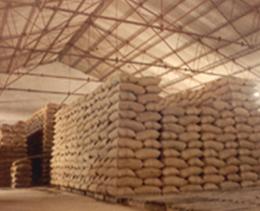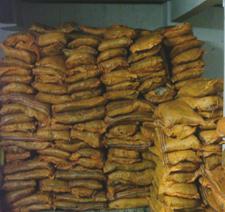RURAL GODOWNS
In India where small and marginal farmers constitute major farming community, do not have the facility to retain the farm products with themselves till the market prices are favourable. It is very much essential to provide them with facilities for scientific storage so that to avoid produce deterioration and enable them to meet their credit requirement. An establishment of rural godowns will enable small and marginal farmers to increase their holding capacity which will make them to sell their produce at remunerative prices and avoid distress sales. Accordingly, Gramin Bhandaran Yojana, a Capital Investment Subsidy Scheme for Construction / Renovation / Expansion of Rural Godowns has been introduced by Govt. of India.

Objectives
The main objectives of the scheme include creation of scientific storage capacity with allied facilities in rural areas to meet the requirements of farmers for storing farm produce, processed farm produce, consumer articles and agricultural inputs; promotion of grading, standardization and quality control of agricultural produce to improve their marketability; prevention of distress sale immediately after harvest by providing the facility of pledge financing and marketing credit; strengthening agricultural marketing infrastructure in the country by paving way for the introduction of a national system of warehouse receipts in respect of agricultural commodities stored in such godowns and to reverse the declining trend of investment in agriculture sector by encouraging private and cooperative sector to invest in the creation of storage infrastructure in the country.
Salient features
The project for construction of rural godowns can be taken up by individuals, farmers, group of farmers/Growers, Partnership/ Proprietary firms, Non-Government Organizations (NGO’s), Self Help Groups(SHGs), Companies, Corporations, Co-operatives, Agricultural Produce Marketing Committees, Marketing Boards and Agro Processing Corporations in the entire country. Assistance for renovation/ expansion of rural godowns will however, be restricted to the godowns constructed by cooperatives only.
Eligibility
Individual farmers for storing Agricultural produce, Entrepreneurs and groups of persons engaged in storing and marketing of Agricultural commodities will be financed under the scheme for establishment of Rural Godowns. Persons who are engaged in storing of Agricultural produce with an idea of hoarding will not be considered under the scheme. Loans under tie up arrangements with Food Corporation of India (FCI), State Ware Housing Corporations (SWCs) and reputed corporations with suitable tripartite agreements will also be considered under the scheme.
Location
Rural areas as per the definition of NABARD are to be included under the scheme provided there is sufficient production and availability of potentiality. The structure shall be located on a well-drained site not liable to flooding or inundations and it shall be away from a place likely to be affected by seepage water.
Capacity
Godowns with capacity up to a maximum of 10000 MT capacities will be financed under the scheme.

Loan amount :
2/3 rd of the cost of estimation will be allowed as a loan amount under the scheme. The cost of estimation should not include land cost. If the project is eligible for subsidy, the margin amount can be reduced to 25% of project cost.
Repayment schedule :
12 to 15 years, including grace period of 12 months. Normally, the construction of godown should be completed within 6 months of disbursement of bank loan. Repayments are to be made in quarterly installments.
Rate of interest :
Interest at the rate of Prime Lending Rate (PTLR) will be charged for loans up to Rs.2.00 lakhs and at PTLR + 1% for loans above Rs.2.00 lakhs. For the loans under tie-up arrangement with CWC/SWC/FCI, interest at PTLR will be charged.
Security :
Primary security of the site and the godowns constructed there on, Collateral security is to be obtained at least 100% of loan amount.
Insurance :
The godowns including the stock there in are to be fully insured against all possible risks.
For safe storage
Selection of godown
The bags of grains should be stored in covered premises, which is well protected from sun, heat, moisture, excessive heat, insects and rodents. The godown should be made on a well built platform of a height of not less than 1ft. from ground level to prevent soil moisture and dampness. The roof of the godown should be sufficient height from the grain stacks for keeping minimum possible temperature in godown. Sufficient space should be provided between stacks for proper air circulation in storage.
Cleaning of godowns
Godown should be properly cleaned so that there should be no left over grains which may harbour infestation and contaminate the new stock. The wall of godown should be whitewashed along with painting of wall with coal tar up to the height of 1 ½ meter. Before storage, the godown should be sprayed with Malathion or DDVP. Besides, care should be taken also for filling up of cracks and crevices of godowns, which is also the harbour crawling infestation.
Cleaning and drying
Before storage, the grain should be properly cleaned and dried so that it should be free from dust, dirt particles and simultaneously should be free from moisture.
Separate storage
To check crawling infestation and to maintain hygienic condition of godown, the old and new stock should to be stored separately
Cleaning of bags
Always new and dry gunny bags should be used for oilseeds storage. The old gunny bags can be used only after cleaning it, drying in sun sand and fumigating by Aluminium Phosphide.
Cleaning of vehicles
The vehicles used for transporting grains should be cleaned with phenyl.
Use of dunnage
Bags of grains should not be stored directly on the floor of the godown and it should be kept by arranging wooden crates or bamboo mats along with cover of polythene sheet.
Aeration of godown
To provide regular aeration to the stock in the godown is very essential to maintain the quality of the stock. Hence, proper aeration should be provided during clear weather and care should be taken to avoid aeration during rainy days.
Regular inspection of stocks
To maintain health and hygiene of the stocks, at every fortnight (15 days interval) inspection is essential.
Types of Underground Storage Structures
Underground storage structures are dug out structures similar to a well with sides plastered with cow dung. They may also be lined with stones or sand and cement. They may be circular or rectangular in shape. The capacity varies with the size of the structure.
Advantages
- Underground storage structures are safer from threats from various external sources of damage, such as theft, rain or wind.
- The underground storage space can temporarily be utilized for some other purposes with minor adjustments; and
- The underground storage structures are easier to fill up owing to the factor of gravity.
Surface storage structures
Food grains in a ground surface structure can be stored in two ways - bag storage or bulk storage.
I.Bag storage
- Each bag contains a definite quantity, which can be bought, sold or dispatched without difficulty;
- Bags are easier to load or unload.
- It is easier to keep separate lots with identification marks on the bags.
- The bags which are identified as infested on inspection can be removed and treated easily; and
- The problem of the sweating of grains does not arise because the surface of the bag is exposed to the atmospheres.
II.Bulk or loose storage
Advantages
- The exposed peripheral surface area per unit weight of grain is less. Consequently, the danger of damage from external sources is reduced; and
- Pest infestation is less because of almost airtight conditions in the deeper layers.
- The government of India has made efforts to promote improved storage facilities at the farm level.
Improved grain storage structures
I.For small-scale storage
PAU bin :
This is a galvanized metal iron structure. It s capacity ranges from 1.5 to 15 quintals. D It was designed by Punjab Agricultural University.
Pusa bin :
This is a storage structure is made of mud or bricks with a polythene film embedded within the walls.
Hapur Tekka :
It is a cylindrical rubberised cloth structure supported by bamboo poles on a metal tube base, and has a small hole in the bottom through which grain can be removed.
II.For large scale storage
CAP Storage (Cover and Plinth) :
It involves the construction of brick pillars to a height of 14" from the ground, with grooves into which wooden crates are fixed for the stacking of bags of food grains. The structure can be fabricated in less than 3 weeks. It is an economical way of storage on a large scale.
Silos :
In these structures, the grains in bulk are unloaded on the conveyor belts and, through mechanical operations, are carried to the storage structure. The storage capacity of each of these silos is around 25,000 tonnes.
|


